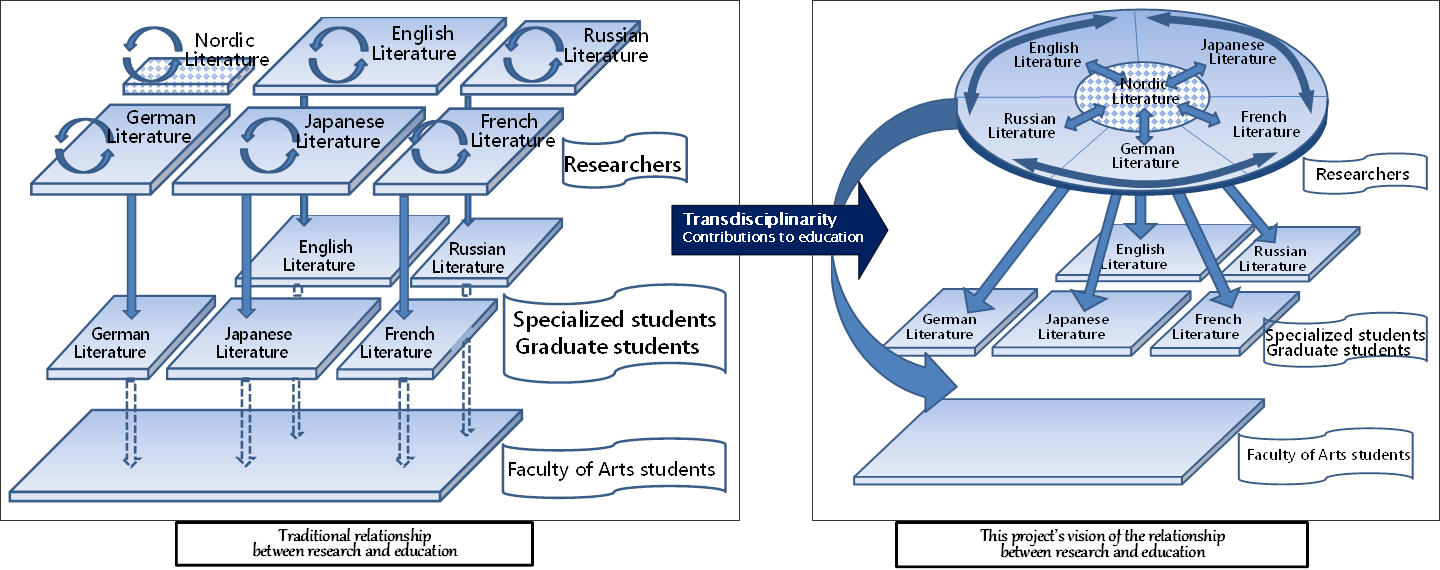Home > About us
About us
History
Project Mermaid was launched in December 2011 as a joint research project by scholars of literatures of various languages, using Andersen’s “The Little Mermaid” as a common text.
What makes this project unique is that the research is conducted jointly by scholars studying literatures of different languages—as opposed to the traditional literary research approach of studying literature in terms of one language or country (Japanese literature, Anglo-American literature, French literature, German literature, etc.)—and the fact that the literatures of languages as minor as Scandinavian languages are included therein. A topic of common interest for each of the participants is that a text as tangible as “The Little Mermaid” was chosen over an abstract theme that would be difficult to relate to their respective research subjects.
In the process of sharing each other’s research at seminars, it once more became clear that all the participants shared a strong interest in the manner of communicating the results of their specialized research, including aspects such as visual effects and presentation methods. The liberal arts came into focus as a grounded and practical platform; it was then that the project began targeting the presentation of a model in which specialized research results are directly passed on to liberal arts education.
Since 2013, the project has been operating under the theme “Andersen’s ‘The Little Mermaid’ as a work of world literature: Transdisciplinary research and modeling for application in liberal arts education” with the support of a Grant-in-Aid for Scientific Research (C) from the Japan Society for the Promotion of Science. At present, each of the participants is writing conference presentations and papers, taking seminars held three times a year to provide a reference point, and is thus contributing to our aim of publishing collections of papers and textbooks. See the “Past seminars” area for documentation and outlines from past seminars.
Andersen’s “The Little Mermaid”
“The Little Mermaid” was chosen as a common text for Project Mermaid for four reasons:
1. Universal motif: Mermaids appear in literature and art of all ages and regions. Therefore, they allow for comparisons from different angles across a multiplicity of literatures and cultures.
2. Work in a minor language: “The Little Mermaid” was written in Danish. Although Danish is a minor language spoken by only about 5.5 million people, “The Little Mermaid” has been translated into more than 180 languages and has therefore become a work of “world literature.” By choosing to center on this work, we aim to shift perspective from traditional literary studies that are centered on the major languages.
 3. Complexity of themes: “The Little Mermaid” allows for multifaceted discussions from varied viewpoints and disciplines, comprising literary motifs such as the body (disability in the legs, human-creature hybrids, voice, pain, blood) and nature (the sun, the sea, air), social and historical contexts (class distinctions, minorities, institutions), as well as research methods such as translation, reception and education.
3. Complexity of themes: “The Little Mermaid” allows for multifaceted discussions from varied viewpoints and disciplines, comprising literary motifs such as the body (disability in the legs, human-creature hybrids, voice, pain, blood) and nature (the sun, the sea, air), social and historical contexts (class distinctions, minorities, institutions), as well as research methods such as translation, reception and education.
4. Suitability for liberal arts: The work is widely known from picture books and movies, constitutes an easily digestible volume (the full translation in Japanese spans about 20 pages), and is written in plain language. Various interpretations can be offered from the particular approaches that capture the interests of the students.
Transdisciplinary research
In Project Mermaid, literary scholars of various languages loosely share the different themes contained in “The Little Mermaid” and reflect their individual readings of the work in their own research specializations.
All participants are accomplished literary scholars in their respective languages and have deployed different research methods ranging from author and reception studies to media and representational culture studies. In this project, they select a number of the multiple themes associated with “The Little Mermaid” that relate to their own specialties and carry out their research sharing those themes with the other participants. Please refer to the “Member profiles” to learn more about the individual research of the participants and their respective roles in this project.

Liberal Arts
In academic education, the results of specialized research have traditionally been passed on to only a limited target group of scholars, specialized students, and graduate students within the same field of study. However, in recent years, there is a growing need to give a wider variety of other groups, including liberal arts students and working members of society, access to the benefits of such research activities.
In Project Mermaid, participants incorporate their research results in real time in classes at their affiliated universities and in public seminars. For regular students and working adults, the project holds introductory classes designed to present the work and its biographical, societal, and literary background, while for students specializing in literature, high-school students aspiring to enter literature departments, and graduate students, the project holds classes designed to deepen the students’ understanding of literary research methodologies. Through these practical activities, it will be possible to accumulate effective teaching materials, methods for using visual media, and other useful educational information and thereby develop a model that directly reflects research results in the liberal arts.